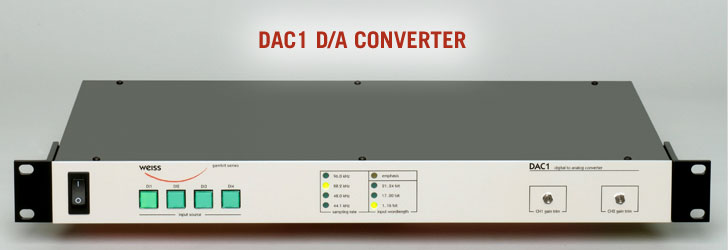We will notify you as soon as the product is in stock in our warehouse! The orders will be placed in priority order and we do not guarantee that the price will remain the same.
-
Free Shipping
-
36 Instalments
-
 2 Years Warranty
2 Years Warranty
-
Free Shipping
-
36 Instalments
-
 2 Years Warranty
2 Years Warranty

The DAC1 is a stereo 24 bit / 96khz D/A converter designed with the aim of keeping an absolutely uncompromised audio signal path. Much detail and thought was spent on the digital input as well as the analogue output stage. Both have in common the purest possible approach in audio design, aspiring for nothing less than excellence.
This is coupled with an ergonomic design that gives the user immediate access to all necessary functions, while keeping an uncluttered and thus easy-to-use front panel. This combination makes a truly professional D/A converter catering for the highest expectations. Inputs: There are three digital inputs on XLR connectors, and one on Toslink (optical). The accepted sampling frequencies are 44.1, 48, 88.2 and 96kHz. AES/EBU signals on a single connector are used. Each XLR input is actively routed to a corresponding XLR digital output, allowing monitoring at multiple stages in a digital studio setup.
Synchronization:
Several signal reclocking schemes are combined for extremely high jitter attenuation, making the DAC1 virtually immune to jitter over a very wide bandwidth.
Converters:
The correlation technique (using two converters per channel) which was already successfully employed in the ADC1 gives the DAC1 an edge over other D/A converters with equal wordlength and sampling rate specifications, resulting in improved SNR and THD.
Outputs:
The discrete Class A outputs have a virtually zero Ohm output impedance, but still can drive large loads without stability problems. Output levels can be set between -infinity and +27dBu.
The outputs are symmetrical, but do not have any sound degrading servo mechanisms built in. For asymmetrical operation only one leg of the XLR connector (plus ground) is used. Remote: By hooking up an analog potentiometer or fader to the remote connector, the output level can be remote controlled. This level control happens in the digital domain. The input source selection can also be remote controlled.
How would you rate this product?
Stock Notice






